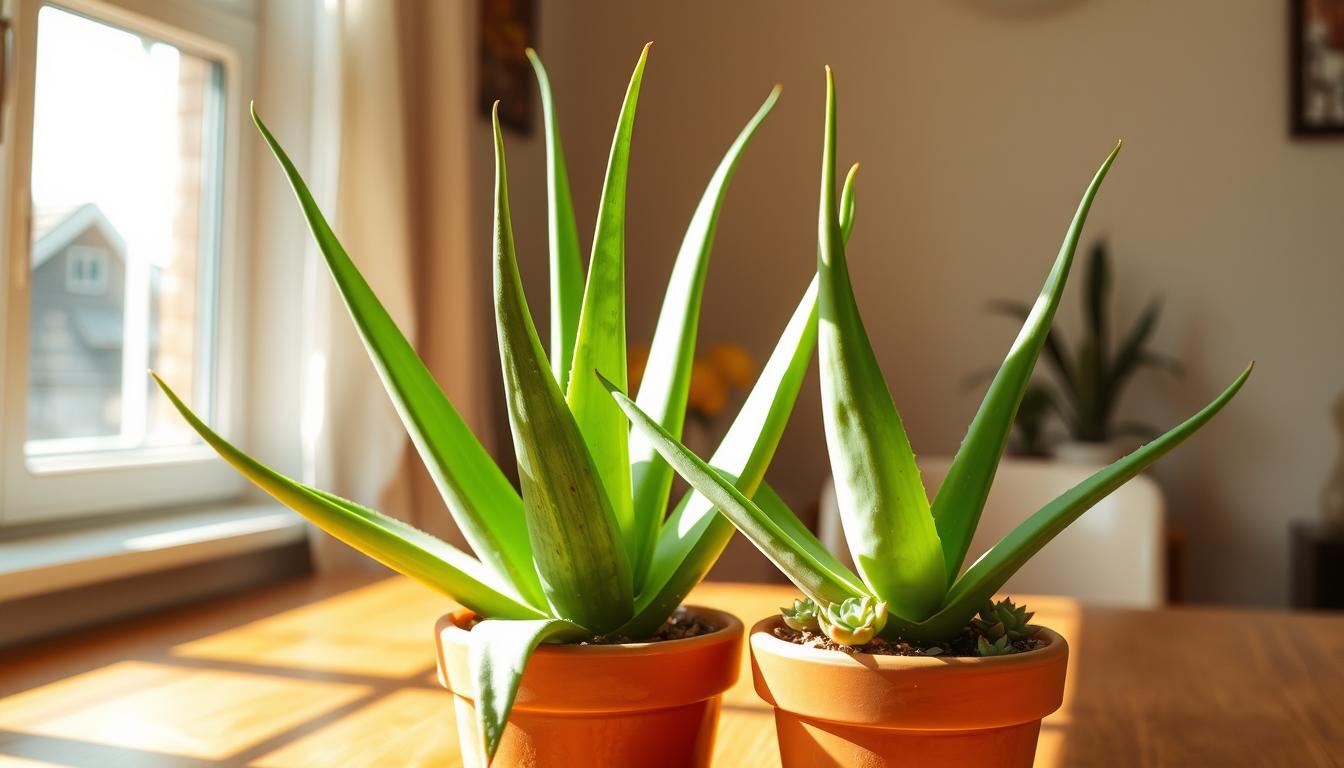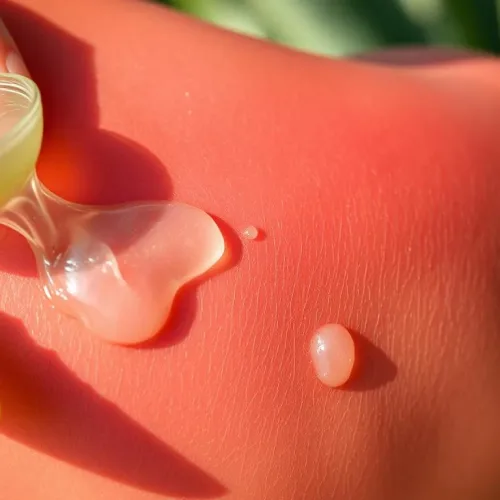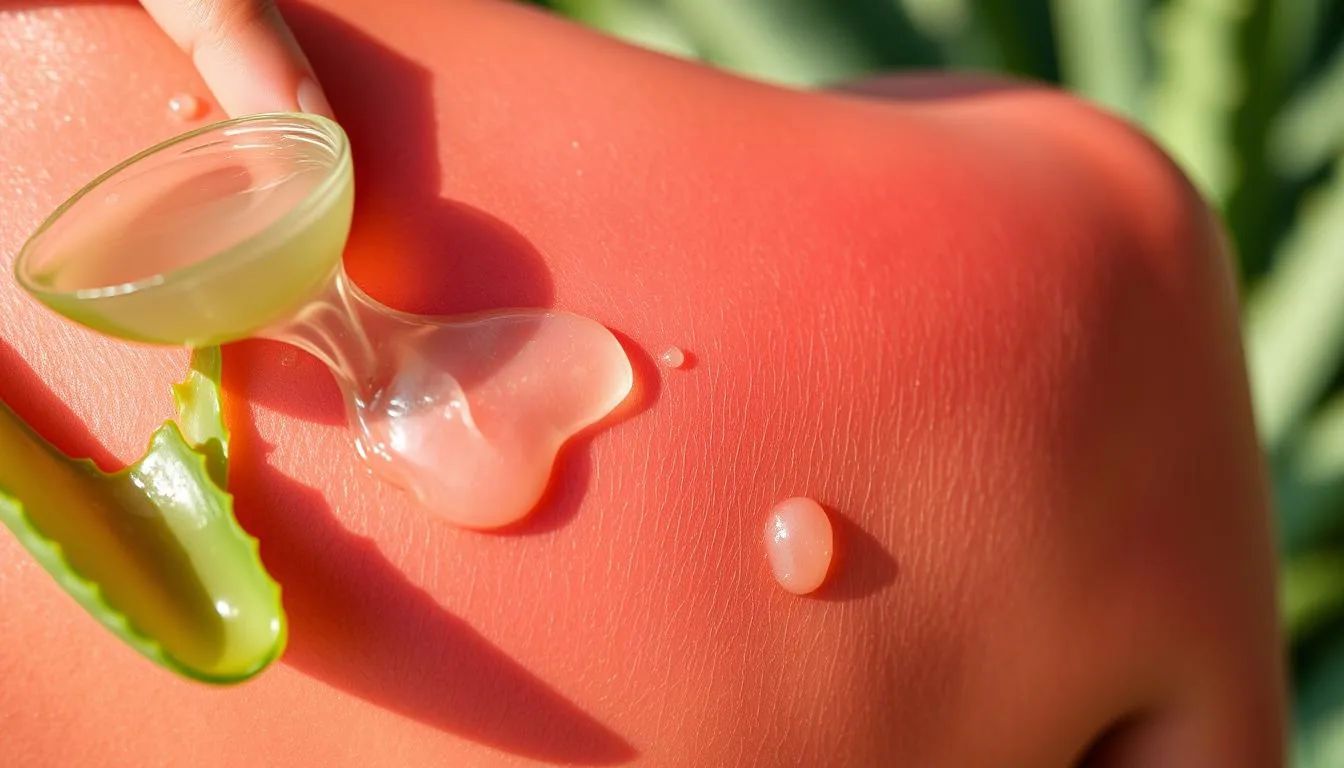Aloe vera is not just a trendy houseplant; it’s a natural remedy powerhouse that can purify the air and soothe your skin. With over 300 species, Aloe vera is one of the most versatile and beneficial plants you can grow indoors.
Growing Aloe vera at home is easier than you think, even for those new to gardening. This resilient plant thrives in indoor conditions, requiring minimal care. Not only does it remove toxins from the air, but it also provides a natural solution for common skin issues like acne, cuts, and sunburns.
- The Dual Benefits of Growing Aloe Vera Plants
- Why You Should Grow Aloe Vera at Home
- Selecting the Perfect Aloe Vera Plant
- Essential Pot and Soil Requirements
- How to Grow Aloe Vera at Home: Step-by-Step Planting Guide
- Mastering Aloe Vera Care: Water and Light Requirements
- Long-Term Aloe Vera Maintenance
- Troubleshooting Common Aloe Vera Problems
- Conclusion
-
FAQ
- How often should I water my Aloe vera plant?
- What is the best way to propagate Aloe vera?
- Why is my Aloe vera plant turning yellow or brown?
- Can I grow Aloe vera from seeds?
- How much light does Aloe vera need?
- What is the ideal temperature for growing Aloe vera?
- How do I fertilize my Aloe vera plant?
- Why is my Aloe vera plant infested with pests?
- Can I use Aloe vera gel directly from the plant?
- How do I repot my Aloe vera plant?
- The Dual Benefits of Growing Aloe Vera Plants
- Why You Should Grow Aloe Vera at Home
- Selecting the Perfect Aloe Vera Plant
- Essential Pot and Soil Requirements
- How to Grow Aloe Vera at Home: Step-by-Step Planting Guide
- Mastering Aloe Vera Care: Water and Light Requirements
- Long-Term Aloe Vera Maintenance
- Troubleshooting Common Aloe Vera Problems
- Conclusion
-
FAQ
- How often should I water my Aloe vera plant?
- What is the best way to propagate Aloe vera?
- Why is my Aloe vera plant turning yellow or brown?
- Can I grow Aloe vera from seeds?
- How much light does Aloe vera need?
- What is the ideal temperature for growing Aloe vera?
- How do I fertilize my Aloe vera plant?
- Why is my Aloe vera plant infested with pests?
- Can I use Aloe vera gel directly from the plant?
- How do I repot my Aloe vera plant?
Key Takeaways
- Learn the basics of growing Aloe vera indoors.
- Discover the air-purifying benefits of Aloe vera.
- Explore the natural remedy uses of Aloe vera for skin care.
- Understand the minimal care requirements for Aloe vera.
- Find out how Aloe vera can be a great addition to your home.
The Dual Benefits of Growing Aloe Vera Plants
The aloe vera plant is a versatile and beneficial addition to any home, offering natural remedies, decorative appeal, and sustainability benefits. For centuries, aloe vera has been valued for its healing properties, and its low-maintenance requirements make it an ideal houseplant.
Natural Healing Properties
Aloe vera is renowned for its natural healing properties, particularly in skincare. The gel inside the leaves can be used to soothe sunburns, minor cuts, and skin irritations. It has anti-inflammatory properties that can help reduce redness and promote healing. Using aloe vera as a natural remedy can be a healthier alternative to commercial skincare products that often contain harsh chemicals.
Some of the key benefits of aloe vera’s healing properties include:
- Soothing sunburns and reducing heat
- Healing minor cuts and abrasions
- Reducing inflammation and redness
- Moisturizing the skin without clogging pores
Low-Maintenance Houseplant Appeal
Aloe vera plants are incredibly hardy and can thrive with minimal care, making them perfect for busy individuals or those new to gardening. They can tolerate infrequent watering, require less pruning compared to other plants, and can survive in a variety of lighting conditions. This low-maintenance appeal is a significant advantage for those looking to bring some greenery into their homes without the hassle.
To keep your aloe vera plant healthy, remember to:
- Water sparingly, allowing soil to dry between waterings
- Provide adequate sunlight, but avoid direct harsh rays
- Repot every few years to maintain soil quality
Sustainability Benefits
Growing aloe vera at home is not only beneficial for personal use but also contributes to a more sustainable lifestyle. Aloe vera plants are relatively easy to propagate, reducing the need for frequent purchases of new plants. Additionally, using aloe vera gel reduces reliance on commercially packaged skincare products, thereby decreasing plastic waste. By choosing to grow your own aloe vera, you’re making an environmentally conscious decision.
“Aloe vera is a symbol of sustainability and natural wellness, offering a simple yet effective way to enhance our well-being while caring for the planet.”
Why You Should Grow Aloe Vera at Home
Aloe vera is a versatile plant that offers numerous benefits when grown at home. Not only is it a natural and low-maintenance addition to any indoor space, but it also provides several advantages that can enhance your living environment and personal well-being.
Air Purification Capabilities
One of the significant benefits of growing aloe vera at home is its ability to purify the air. Aloe vera plants are known to remove harmful toxins and pollutants from the air, contributing to a healthier indoor environment. This natural air purification process can lead to improved respiratory health and overall well-being.
On-Demand Skincare Remedy
Having aloe vera at home means having a natural remedy for various skin issues at your fingertips. Aloe vera gel can be used to soothe sunburns, hydrate the skin, and even help with minor cuts and abrasions. This on-demand access to a natural skincare solution can be incredibly beneficial for maintaining healthy, glowing skin.
Using aloe vera as a skincare remedy is simple: just slice open a leaf, extract the gel, and apply it directly to the affected area. This natural remedy is free from harsh chemicals, making it suitable for all skin types.
Decorative Appeal for Any Space
Aloe vera plants are not just beneficial for health and skincare; they also add a touch of natural beauty to any indoor space. Their unique, succulent appearance can complement a variety of decor styles, from modern to traditional. Whether you’re looking to enhance your living room, kitchen, or bedroom, aloe vera plants can be a stylish and functional addition.
Choosing the right pot for your aloe vera can further enhance its decorative appeal. Consider a pot that complements your home decor and provides the necessary drainage for healthy plant growth.
Selecting the Perfect Aloe Vera Plant
The journey to growing Aloe Vera at home begins with selecting the right plant. With so many varieties and sources available, this initial step can be both exciting and overwhelming. However, by understanding what to look for, you can ensure a strong start for your Aloe Vera cultivation journey.
Identifying True Aloe Vera Varieties
Not all Aloe Vera plants are created equal. The most beneficial variety for medicinal use is Aloe barbadensis Miller. This variety is renowned for its healing properties and is the type most commonly referenced in health and skincare discussions.
What to Look for When Buying
When purchasing an Aloe Vera plant, there are several factors to consider:
- Look for plants with plump, green leaves. Avoid those with brown spots or soft, mushy leaves.
- Check the roots by gently removing the plant from its pot. Healthy roots are firm and white.
- Opt for plants with multiple offsets or “pups” around the base, as these indicate a mature, healthy plant.
Avoiding Common Purchase Mistakes
One of the most common mistakes when buying Aloe Vera is purchasing plants that are not suitable for your environment or needs. Be wary of:
- Plants that are too large for their containers, as this can indicate root bound conditions.
- Plants with signs of pests or diseases.
| Characteristic | Ideal Condition | What to Avoid |
|---|---|---|
| Leaves | Plump, green | Brown spots, soft, or mushy |
| Roots | Firm, white | Soft, rotting, or circling |
| Offsets/Pups | Multiple, healthy | None or weak |
By following these guidelines, you can confidently select a healthy, thriving Aloe Vera plant that will provide you with years of medicinal and aesthetic enjoyment.
Essential Pot and Soil Requirements
Growing aloe vera at home begins with understanding the essential pot and soil requirements. Aloe vera plants are relatively low-maintenance, but they still need the right conditions to thrive.
Choosing the Right Container Material
The material of the pot can significantly affect the health of your aloe vera plant. Terracotta pots are highly recommended because they are porous, allowing for better air circulation and moisture release, which helps prevent root rot. In contrast, plastic or metal containers can retain too much moisture, potentially harming the plant.
Determining Optimal Pot Size
The size of the pot is also crucial. A pot that is too small may not provide enough room for the roots to grow, while a pot that is too large can cause the soil to become too wet, leading to root rot. A general rule of thumb is to choose a pot that is only slightly larger than the plant’s current size.
Creating the Perfect Soil Mix
Aloe vera plants prefer well-draining soil to prevent waterlogged soil conditions. A mix specifically designed for cacti and succulents is ideal, as it typically contains ingredients like perlite or sand that improve drainage. You can also create your own mix by combining regular potting soil with sand or perlite.
Setting Up Proper Drainage
Proper drainage is critical to prevent root rot. Ensure your pot has drainage holes at the bottom. You can also add a layer of small rocks or broken pottery at the bottom of the pot to enhance drainage. This simple step can significantly reduce the risk of water accumulation in the soil.
“The key to successful aloe vera cultivation lies in replicating its natural habitat as closely as possible, which includes using the right pot and soil.”
By focusing on these essential pot and soil requirements, you can create an optimal environment for your aloe vera plant to grow and thrive.
How to Grow Aloe Vera at Home: Step-by-Step Planting Guide
To successfully cultivate Aloe vera, follow this comprehensive step-by-step planting guide. Growing Aloe vera at home can be a straightforward process if you have the right information.
Propagating from Aloe Pups
One of the most common methods of growing Aloe vera is by propagating from Aloe pups. These pups are essentially the offspring of mature Aloe vera plants and can be used to grow new plants.
- Select healthy pups that are at least one-fifth the size of the mother plant.
- Carefully remove the pup from the mother plant, making sure not to damage the roots.
- Let the pup dry for 1-2 days to form a callus over the wound, which helps prevent rot.
- Plant the pup in well-draining soil, and water sparingly until roots develop.
Growing Aloe Vera from Seeds
Growing Aloe vera from seeds is another viable option, although it can be more challenging and time-consuming.
- Sow the seeds in a seed tray filled with a well-draining seed starting mix.
- Keep the soil moist but not waterlogged, and provide adequate light.
- Transplant the seedlings into individual pots once they are large enough to handle.
Transplanting Mature Plants
If you’re starting with a mature Aloe vera plant, transplanting it into a larger pot or directly into the garden requires some care.
- Choose a pot that is only slightly larger than the current one to prevent the soil from becoming too wet.
- Handle the roots gently, and avoid damaging them during the transplant process.
- Water the plant well after transplanting and keep the soil moist until it’s established.
By following these steps, you can successfully grow Aloe vera at home, whether you’re starting from pups, seeds, or transplanting a mature plant.
Mastering Aloe Vera Care: Water and Light Requirements
To keep your aloe vera thriving, understanding its water and light needs is crucial. Aloe vera is known for its hardiness, but like any plant, it has specific requirements that, when met, ensure it remains healthy and continues to provide its numerous benefits.
Proper Watering Techniques
Watering aloe vera correctly is vital. The soil should be allowed to dry out completely between waterings. Overwatering is a common mistake that can lead to root rot, a condition that can be fatal to the plant. A good rule of thumb is to water your aloe vera sparingly but thoroughly, making sure the pot drains well to prevent waterlogged soil.
When watering, it’s also important to avoid getting water on the leaves to prevent rot. Instead, water should be poured directly into the soil. This method ensures that the roots receive the moisture they need without risking damage to the leaves.
Seasonal Watering Adjustments
Aloe vera’s watering needs change with the seasons. During the summer months, when the plant is actively growing, it may require more frequent watering. Conversely, in the winter, when the plant is dormant, watering should be significantly reduced. Adjusting your watering schedule according to the season is crucial for maintaining the health of your aloe vera.
Finding the Perfect Light Balance
Aloe vera requires bright, indirect light to photosynthesize and grow. Direct sunlight can be too intense and may cause the leaves to become scorched. Placing your aloe vera near a sunny window or under a skylight can provide the right amount of light. If you’re growing your aloe vera indoors, consider using grow lights as a supplement, especially during the darker winter months.
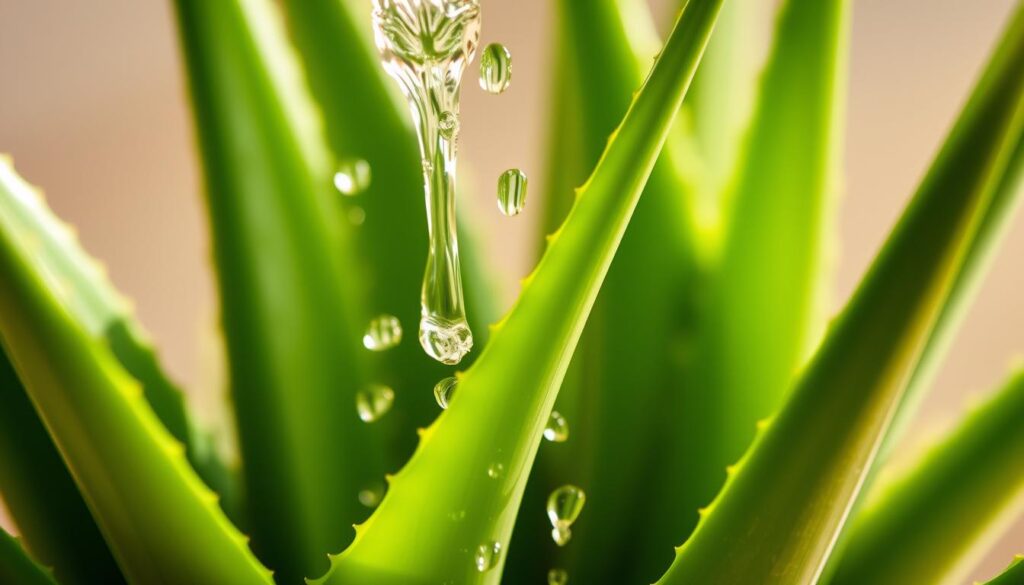
By mastering the water and light requirements for your aloe vera, you can ensure it remains a healthy and vibrant part of your home or garden. Whether you’re a seasoned gardener or a beginner, following these guidelines will help you enjoy the many benefits of this versatile plant.
Long-Term Aloe Vera Maintenance
Long-term care for aloe vera involves a few simple practices that ensure the plant remains healthy and vibrant. By following these guidelines, you can enjoy the benefits of your aloe vera plant for years to come.
Fertilizing Guidelines
Fertilizing your aloe vera plant is a crucial step in its long-term care. Aloe vera plants should be fertilized once a year in the spring when they are actively growing. Use a balanced, water-soluble fertilizer diluted to half the recommended strength to avoid burning the roots.
When and How to Repot
Repotting is necessary when the aloe vera plant becomes pot-bound or top-heavy. Typically, this occurs every 2-3 years. Choose a pot that is slightly larger than the previous one and use a well-draining soil mix to prevent waterlogged soil.
| Repotting Indicator | Action Required |
|---|---|
| Roots are crowded | Repot in a slightly larger container |
| Plant is top-heavy | Repot to prevent the plant from tipping over |
Pruning and Cleaning Tips
Regular pruning and cleaning are essential for maintaining the health and appearance of your aloe vera plant. Remove any dead or damaged leaves to prevent the spread of disease and encourage healthy growth. Clean the leaves with a damp cloth to remove dust and debris.
By following these long-term maintenance tips, you can keep your aloe vera plant thriving and enjoy its numerous benefits.
Troubleshooting Common Aloe Vera Problems
As with any plant, aloe vera can have its share of problems, but most are easily solvable with the right knowledge. When growing aloe vera at home, it’s essential to be aware of the common issues that may arise and how to address them effectively.
Addressing Leaf Discoloration
Leaf discoloration is a common issue with aloe vera plants, often caused by overwatering, underwatering, or exposure to extreme temperatures. If your aloe vera leaves are turning yellow or brown, check your watering schedule and ensure the plant is not sitting in waterlogged soil. Adjusting your aloe vera watering tips can often resolve this issue.
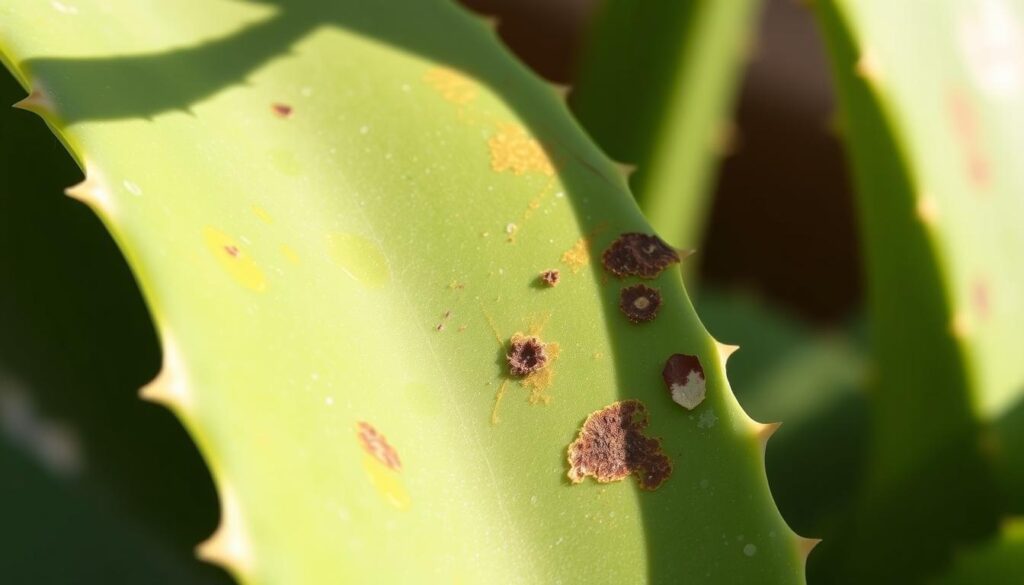
Dealing with Pest Infestations
Pests like mealybugs and spider mites can infest aloe vera plants. To deal with these pests, gently wipe the leaves with a cotton swab dipped in alcohol. Regularly inspecting your plants and maintaining good hygiene can prevent pest infestations.
Fixing Root Rot Issues
Root rot is a serious issue that can be fatal to aloe vera plants. It’s usually caused by overwatering, which leads to the roots rotting. To fix root rot, you need to repot the plant in fresh, well-draining soil and trim away any rotten roots. Ensuring proper drainage and adhering to aloe vera watering tips can prevent this problem.
Reviving a Struggling Plant
If your aloe vera plant is struggling, assess its environment and care routine. Check for signs of overwatering, underwatering, or pests. Adjusting the plant’s position for better light, improving soil drainage, and correcting watering habits can often revive a struggling aloe vera.
Conclusion
Growing Aloe Vera at home is a rewarding experience, offering numerous benefits for your health, skincare routine, and home decor. By following the steps outlined in this guide on how to grow Aloe Vera at home, you can successfully cultivate this versatile plant.
From selecting the right pot and soil to mastering watering and light requirements, we’ve covered the essential aspects of Aloe Vera care. With its natural healing properties, air-purifying capabilities, and low-maintenance requirements, Aloe Vera is an ideal addition to any home.
By understanding how to grow Aloe Vera at home, you can enjoy the many benefits it provides, from soothing skin irritations to enhancing your living space. Start your Aloe Vera journey today and experience the joy of nurturing this incredible plant.
FAQ
How often should I water my Aloe vera plant?
Aloe vera plants should be watered sparingly, allowing the soil to dry out completely between waterings. The frequency of watering depends on the climate and time of year, but as a general rule, water your Aloe vera every 7-10 days in the spring and summer, and less often in the fall and winter.
What is the best way to propagate Aloe vera?
The best way to propagate Aloe vera is by using Aloe pups, which are the small plants that grow around the base of the mother plant. Simply remove the pup from the mother plant, allow it to dry for a few days to form a callus, and then plant it in well-draining soil.
Why is my Aloe vera plant turning yellow or brown?
Aloe vera plants can turn yellow or brown due to overwatering, underwatering, or exposure to extreme temperatures. Check the soil moisture and adjust your watering schedule accordingly. Also, ensure your Aloe vera is receiving the right amount of light and is not exposed to frost or extreme heat.
Can I grow Aloe vera from seeds?
Yes, you can grow Aloe vera from seeds, but it’s a slower and more challenging process than propagating from Aloe pups. Sow the seeds in well-draining soil, keep the soil moist, and provide adequate light. Be patient, as germination can take several weeks to a few months.
How much light does Aloe vera need?
Aloe vera plants prefer bright, indirect light, but can tolerate some direct sunlight. However, be cautious not to expose your Aloe vera to too much direct sunlight, as this can cause the leaves to become scorched. East- or west-facing windows are ideal for Aloe vera plants.
What is the ideal temperature for growing Aloe vera?
Aloe vera plants prefer temperatures between 65°F (18°C) and 80°F (27°C). Avoid exposing your Aloe vera to temperatures below 55°F (13°C) or above 90°F (32°C), as this can cause stress to the plant.
How do I fertilize my Aloe vera plant?
Feed your Aloe vera plant with a balanced, water-soluble fertilizer during the growing season (spring and summer). Dilute the fertilizer to half the recommended strength to avoid burning the roots.
Why is my Aloe vera plant infested with pests?
Aloe vera plants can be susceptible to pests like mealybugs, spider mites, and scale. Inspect your plant regularly, and treat any infestations promptly with insecticidal soap or neem oil.
Can I use Aloe vera gel directly from the plant?
Yes, you can use Aloe vera gel directly from the plant. Simply cut off a leaf, slice it open, and scoop out the gel. Use it to soothe burns, minor cuts, and skin irritations.
How do I repot my Aloe vera plant?
Repot your Aloe vera plant in the spring when it becomes pot-bound. Choose a slightly larger pot with good drainage, and gently remove the plant from its pot, taking care not to damage the roots. Trim any dead or damaged roots before replanting in fresh, well-draining soil.
For world’s best Aloe Vera products Country Wise:
INDIA: CLICK HERE
USA: CLICK HERE
CANADA: CLICK HERE
AUSTRALIA: CLICK HERE
UNITED KINGDOM: CLICK HERE
